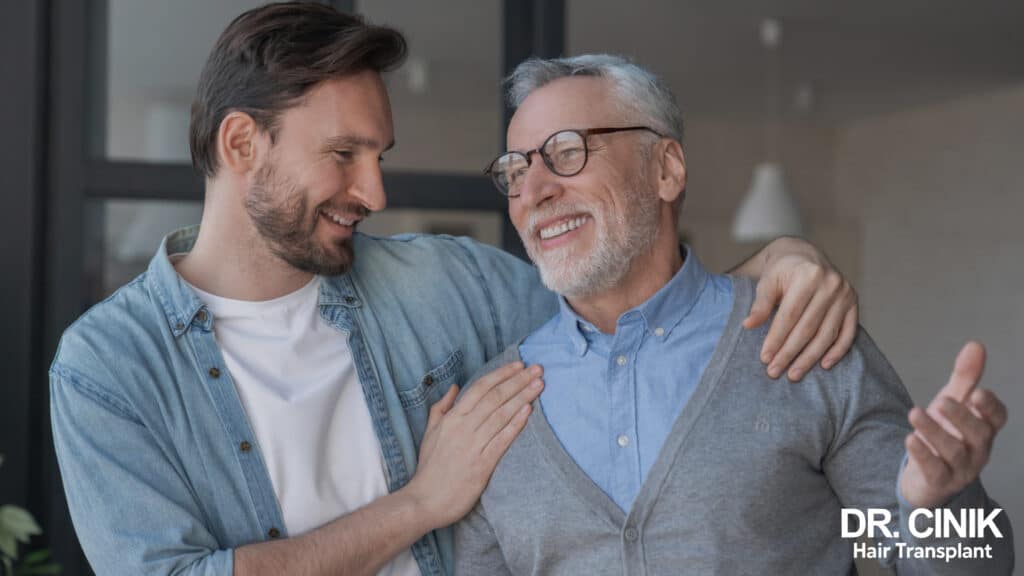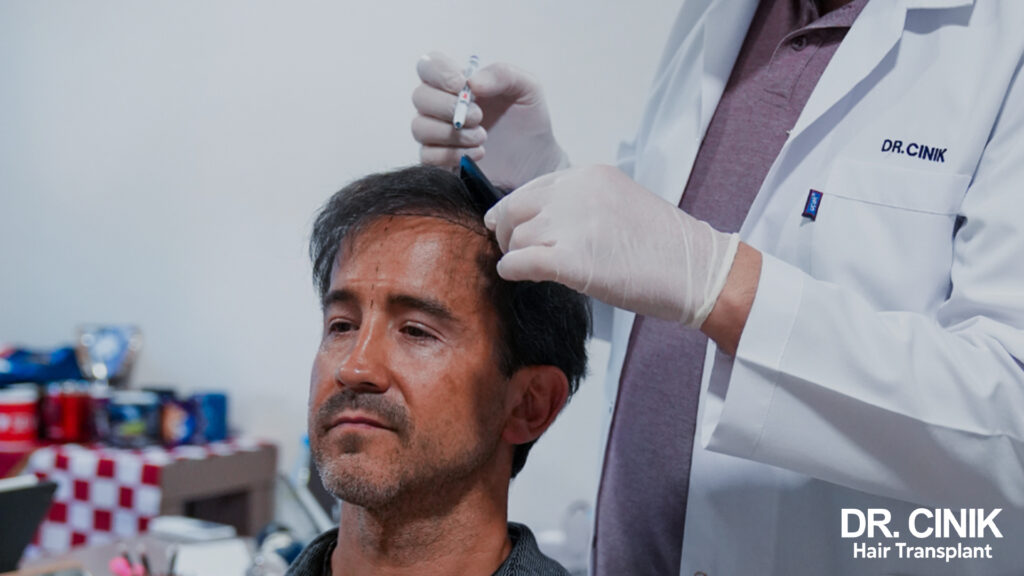Body Hair Transplant: Is It Too Risky to Harvest Body Hair Follicles?

Sommaire
You might have been searching for hair transplant options for a while now, which indicates you are suffering from severe hair loss. Hair transplant is a permanent solution for baldness and gives you the chance to enjoy having a natural hairstyle again. However, as there are many options, terms, and techniques in the field of hair transplant surgery, you can get confused during the decision-making process. One of the terms that can get you confused is “Body Hair Transplant”. This term rises many questions for patients and at Dr. Cinik Hair transplant, most of our patients ask us questions about this technique and its benefits.
What is a body hair transplant? Why and when is it necessary to harvest body hair in a hair transplant surgery? Does it have risks and dangers? What are the advantages and disadvantages of it? We have addressed all your questions in this article.
Stages of a Hair Transplant Operation
To understand why do body hair transplants exist, you need to know the process of a hair transplant and the success factors of a hair transplant. A hair restoration surgery is a multi-step medical surgery, consisting of:
Pre-Op Stage

EKG Test
We make sure your heart won’t be at risk during and after the hair transplant surgery.
Blood Test
We analyze your health condition in great detail to make sure your hair transplant surgery will be safe and successful.
Consultation with Dr. Cinik
Dr. Emrah Cinik checks your hair’s health status, donor hair quality, and old images. Then he determines a natural hairline for you and the number of grafts needed.

Shaving
You can have your full head hair shaved or keep your long hair and just have the donor and recipient area shaved by an unshaven hair transplant. Depending on your baldness, the medical team will make the decision whether full shaving is necessary or regional shaving would be possible. In case they offer body hair transplant procedures, your chest or any other donor area on your body will also need shaving.
Operation

Anesthesia
We will make sure you will experience a minimal level of pain during your hair transplant procedure by using local anesthesia. You can also choose needle-free anesthesia to drop the pain to an extreme extent (by 60-70%). Both your donor and transplant areas need anesthesia. For body hair transplants, the donor on the body also needs anesthetics.
Donor Area Preparation
Your donor area gets disinfected and determined for optimal harvesting. It takes competency and experience to determine a perfect harvesting plan.
Grafts Harvesting
Using motorized punches, grafts are extracted from your donor area, which is usually the nape area on the scalp. It is a very important stage of a hair transplant. Harvested grafts are divided into four groups and prepared for implantation. In case, your donor area on the scalp does not provide enough grafts, grafts can be taken from your beard and body.
Implantation
Sapphire FUE
Implantation has two stages in a Sapphire FUE Hair Transplant. It starts with channel opening, which is followed by implantation. FUE technique is one of the safest hair restoration methods, which removes the difficulties of hair strip surgery.
Sapphire DHI
In the Sapphire DHI technique, implantation is done with Choi pens after channels are opened with the high-quality Sapphire blade. The only difference with the FUE method is merging channel opening and implantation. In Sapphire DHI, both features of DHI and FUE methods are kept in place.
What Are the Success Factors of a Hair Transplant Surgery?

A high-quality hair transplant produces a hairdo that isn’t distinguishable from natural hair. Consider the following list of hair transplant signs if you want to evaluate the success of a hair transplant operation:
Natural Hairline
Determining the hairline takes a lot of practice. Hairlines that are too low or too high, or that lack a natural form, will appear unnatural and odd. It also needs a high level of competence during the implantation process, as unnatural implantation on the front sections damages the whole hairstyle.
Optimally Harvested Donor Area
Overharvesting the donor region or harvesting in equal sections from different parts of the donor area might make it appear odd and unnatural. The damaged donor area can also affect natural hair follicles. In a nutshell, you should not be able to identify a donor area after a hair restoration surgery unless you pay close attention.
Normal Density
The density of transplanted hair follicles on the recipient area should be normal. Unnatural density not only looks odd, but it can also damage healthy hair follicles.
Natural Direction
Doll-shaped hair growth, particularly in the frontal area, is caused by an unskilled surgeon’s channel opening and implantation.
Distribution of 1,2,3, or 4-Follicle Grafts
Hair grafts harvested might have 1 to 4 hairs. The hair transplant staff should identify them, collect them into four groups, and distribute them according to the implantation plan (more density in the front parts and less in the crown plus homogenous distribution on each part). It guarantees that the density is natural.
Minimum Side Effects and Recovery Time
A high-quality hair transplant performed by an experienced team of professionals has few side effects and shortens the healing period.
What Is Body Hair Transplant?
As you can see in the hair transplant steps and success factors, an acceptable density, and a naturally-looking donor area are the most important factors when assessing a hair transplant. In some cases these results cannot be obtained, thus it gets necessary to harvest hair from the beard, chest, legs, or other parts of the body to be implanted on the scalp. The process of harvesting hair follicles from parts other than the nape area is called Body (and beard) hair transplantation.
Body to Scalp Transplantation supports the density of transplanted hair on the scalp to get high-quality results of hair restoration surgery, offering promising densities.
When Is Body Hair Transplant Necessary?
Body hair transplant is a supportive method for a hair transplant when:
- The donor area on the scalp cannot provide enough healthy hair grafts.
- The balding area is large and requires a large number of grafts to be covered which is not possible to be harvested from the nape.
In such cases, the medical team harvests hair follicles from the beard, chest, legs, or other parts of the body which can provide healthy hair follicles.
What Are the Advantages of Body Hair Transplant?
As density is an important factor in the look of hair, achieving a higher density is the main advantage of using body hair follicles as donor grafts. Body hair follicles are native to the person and after implantation, they continue their normal life on the transplanted area.
What Are the Disadvantages of Body Hair Transplant?
Body and beard hair follicles are not exactly of the same quality as the scalp hair follicles are. They have limited growth and are thinner and curlier than the hair on the head. The hair transplant cannot use these grafts on the frontal parts as they cannot give a natural look and grow as long and fast as natural hair on the scalp.
Should I Avoid Body Hair Transplant?
Body hair transplant is generally a risky and technically difficult procedure that requires to be performed by a highly skilled and experienced medical team. If your surgeon is a well-trained and experienced medical doctor, who has performed successful body hair transplants before, you can trust them to perform it for you if it is identified to be necessary. Unless your surgeon is a highly trained and experienced doctor, you should not undergo a body hair transplant.
Your doctor should analyze your donor area and calculate the number of grafts required for the desired coverage. If it turns out that your donor area on the scalp cannot provide enough hair grafts, your surgeon will suggest using beard or body hair grafts.
Do Body and Beard Hair Transplants Look Natural?
Body hair follicles are not preferred to be used on the frontal parts of the hair and are mainly used on the crown for adding density. If a professional surgeon performs hair transplant surgery, they can use body hair follicles and implant them in an optimal pattern and an optimal number to avoid risks of odd and unnatural hair after the transplantation.
Body hair follicles are thinner, curlier, and grow less than normal hair. These make using them risky, requiring a very experienced medical team. Make sure you have checked real examples of body hair transplants from the surgeon you have decided to trust for your own hair transplant.
Is Body Hair Transplant Successful?
Like other hair transplant techniques, there are several factors that make a body hair transplant successful. However, considering the different properties of body hair follicles, the risk of unsuccessful transplants rises in body hair transplants. If proper planning and channel opening are done for body hair follicles, it will provide natural permanent results, so we can say body hair transplants work well if done under special conditions by a professional team.
Recovery Period of the Body Hair Transplant
The recovery period in the hair transplant operations accompanied by a body hair transplant is pretty similar to that of a normal hair transplant. You should treat and take care of the donor areas on the body as the donor area on the scalp. If you are planning to harvest hair follicles from the donor areas on your body, you have to wait for at least 9 months to let the donor area recover completely. To learn more about post-op care you can read our post-op guidelines.
Body and Beard Hair Transplant at Dr. Cinik Hair Transplant
Dr. Emrah Cinik, the experienced plastic surgeon, has led and performed thousands of successful hair transplant surgeries in his professional career. In his hair transplant center, Dr. Cinik Hair Transplant, hundreds of patients have undergone body hair transplants due to their special situation, almost all of which have turned out to have successful results.
Dr. Emrah Cinik determines whether or not you need to have a body hair transplant at the consultation session. He follows a strict procedure to make sure you will get the best results after the surgery. To determine a treatment plan, you can get a free consultation here.
Body Hair Transplant: A Summary Review
You might have seen this term while searching for hair transplant options. Body hair transplant is an evolving option (Read more) for people whose donor area cannot provide enough healthy hair for full coverage to increase the density on their scalp. However, body and beard hair does not have the same properties as the hair on the scalp. The medical team cannot use extracted grafts from the body and beard freely and needs special treatments while implanting.
Body hair transplant can also be highly risky if less experienced medical teams do it and it is not logical to undergo this procedure unless a well-established and experienced hair transplant center does it.
 en
en



